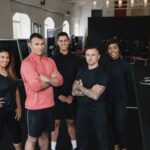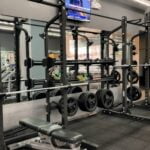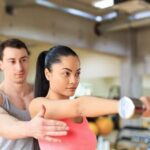Embarking on a journey to improve one’s overall health and well-being often starts with incorporating basic fitness exercises into one’s routine. These fundamental exercises serve as the building blocks for a strong foundation in physical fitness, making them essential for individuals of all fitness levels. Whether you’re just starting out or looking to enhance your current workout regimen, mastering these basic exercises can have a significant impact on your health.
Regularly engaging in basic fitness exercises offers a myriad of benefits that go beyond just physical strength and endurance. From improving cardiovascular health and promoting weight loss to enhancing flexibility and boosting mood, these exercises play a crucial role in achieving holistic wellness. By focusing on simple movements and proper form, individuals can lay the groundwork for more advanced workout routines while reaping the rewards of improved overall health.
In this article, we will explore the importance of integrating basic fitness exercises into your daily routine, highlighting the key benefits that come with such practices. Whether you’re a beginner looking to kickstart your fitness journey or someone seeking to elevate their workout performance, understanding the significance of these foundational exercises is paramount.
Stay tuned as we delve into the top five basic fitness exercises for beginners, along with tips on how to warm up effectively and avoid common mistakes during workouts.
Benefits of Incorporating Basic Fitness Exercises Into Your Routine
Improved Physical Health
Incorporating basic fitness exercises into your routine can have numerous benefits for your physical health. Engaging in activities like cardio, strength training, and flexibility exercises can improve your cardiovascular health, build muscle strength, and enhance flexibility. These exercises also help to boost metabolism, burn calories, and maintain a healthy weight. Regular participation in basic fitness exercises can reduce the risk of chronic diseases such as heart disease, diabetes, and obesity.
Enhanced Mental Well-Being
Apart from physical health benefits, basic fitness exercises also play a crucial role in enhancing mental well-being. Exercise has been linked to the release of endorphins – the feel-good hormones that can help reduce stress, anxiety, and symptoms of depression. Incorporating basic fitness exercises into your routine can improve cognitive function, enhance mood, and promote better sleep patterns. Additionally, engaging in physical activity provides a sense of accomplishment and boosts self-confidence.
Increased Energy Levels
One of the key benefits of incorporating basic fitness exercises into your routine is increased energy levels. Regular physical activity can improve blood circulation throughout the body, delivering oxygen and nutrients to cells more efficiently. This leads to improved energy levels and overall vitality.
By engaging in basic fitness exercises regularly, you may find that you have more stamina to tackle daily tasks and activities with ease. Additionally, exercise can help reduce feelings of fatigue and lethargy by promoting better overall health and well-being.
Top 5 Basic Fitness Exercises for Beginners
Getting started on a fitness journey can be overwhelming, especially for beginners. However, incorporating basic fitness exercises into your routine is crucial for improving overall health and well-being. These exercises are simple yet effective in building strength, improving flexibility, and boosting cardiovascular health. By including these basic exercises in your workout regimen, you can set a solid foundation for more advanced routines in the future.
Squats
One of the best basic fitness exercises for beginners is squats. Squats are great for targeting multiple muscle groups, including the quadriceps, hamstrings, and glutes. To perform a squat properly, stand with your feet hip-width apart, bend your knees and lower your body as if you’re sitting back into an imaginary chair.
Make sure to keep your chest up and your back straight throughout the movement. Squats can be modified based on your fitness level by using dumbbells or resistance bands to increase intensity.
Push-Ups
Push-ups are another essential basic exercise that works multiple muscle groups simultaneously. They target the chest, shoulders, triceps, and core muscles.
To do a proper push-up, start in a plank position with your hands shoulder-width apart, lower your body until your chest touches the floor, and push back up to the starting position. If traditional push-ups are too challenging, you can modify them by doing knee push-ups or incline push-ups against a bench or wall.
Planks
Planks are excellent for strengthening the core muscles and improving overall stability. To perform a plank, get into a push-up position but instead of lowering yourself down to the floor, hold yourself up on your forearms and toes while keeping your body in a straight line from head to heels. Engage your core muscles throughout the exercise to maximize its effectiveness. Planks can be held for as long as you can maintain proper form or timed for specific intervals.
Incorporating these top 5 basic fitness exercises into your routine as a beginner will help you build a strong foundation for more advanced workouts in the future. Remember to focus on proper form and technique to prevent injuries and maximize results. Consistency is key when it comes to seeing progress in your fitness journey, so make sure to stay committed and motivated along the way.
How to Properly Warm Up Before Starting Basic Fitness Exercises
Warming up before starting any basic fitness exercises is crucial to prepare your body for the workout ahead. A proper warm-up routine helps increase blood flow to the muscles, improves flexibility, and reduces the risk of injury during exercise. One of the most effective ways to warm up is to engage in dynamic stretching exercises that target multiple muscle groups.
Some examples of dynamic stretching exercises you can include in your warm-up routine are leg swings, arm circles, hip rotations, and torso twists. These movements help loosen up tight muscles and joints, allowing for a greater range of motion during your workout. It is important to perform each stretch smoothly and gradually increase the intensity to avoid overstretching or straining your muscles.
In addition to dynamic stretching, incorporating five to ten minutes of light cardio such as brisk walking or jogging can also be beneficial in raising your heart rate and increasing circulation. This combination of dynamic stretching and light cardio will effectively prepare your body for the basic fitness exercises ahead, helping you get the most out of your workout while minimizing the risk of injury.
| Dynamic Stretches | Benefits |
|---|---|
| Leg swings | Loosens up tight leg muscles |
| Arm circles | Improves shoulder mobility |
| Hip rotations | Increases hip flexibility |
| Torso twists | Engages core muscles |
Common Mistakes to Avoid When Doing Basic Fitness Exercises
When starting a fitness journey, it can be tempting to dive right into a rigorous workout routine without proper guidance. However, this approach often leads to common mistakes that can hinder progress and even cause injury. To ensure you get the most out of your basic fitness exercises, it is important to avoid these pitfalls:
- Skipping Proper Form: One of the most common mistakes people make when doing basic fitness exercises is neglecting proper form. Whether it’s squats, push-ups, or lunges, maintaining correct posture is essential to effectively target the intended muscle groups and prevent injury.
- Not Listening to Your Body: Pushing yourself too hard too soon can lead to overtraining and burnout. It’s important to listen to your body and give yourself adequate rest days to allow for recovery.
- Neglecting Warm-Up and Cool Down: Failing to warm up before exercising can increase the risk of injury, while skipping a cool down can lead to muscle soreness. Incorporating dynamic stretches and foam rolling into your routine can help prep your body for exercise and aid in recovery.
By being aware of these common mistakes and taking steps to correct them, you can ensure that your basic fitness exercises are both effective and safe. Remember that consistency is key when it comes to seeing results, so focus on building a strong foundation with proper form and gradual progression.
It’s also important to remember that everyone’s fitness journey is unique, so don’t compare yourself to others or get discouraged by setbacks. Celebrate small victories along the way and keep pushing yourself towards your goals. With dedication and perseverance, you will see improvements in your overall health and fitness level through these basic fitness exercises.
How to Progressively Increase the Intensity of Basic Fitness Exercises
Progressively increasing the intensity of your basic fitness exercises is crucial for continued improvement in your overall health and fitness levels. By challenging your body with higher intensity workouts, you can prevent plateaus and keep seeing results. One effective way to increase intensity is by adjusting variables such as weight, repetitions, sets, or rest periods. This ensures that your body is constantly adapting and getting stronger.
One method to increase intensity is by incorporating resistance training into your basic fitness routine. This can include using dumbbells, resistance bands, or even just your body weight to add an extra challenge to your exercises. For example, if you have been doing bodyweight squats as part of your routine, you can progress to goblet squats with a dumbbell held at chest level for added resistance.
Another way to ramp up the intensity of your basic fitness exercises is by implementing interval training. This involves alternating between high-intensity bursts of activity and short rest periods. For instance, if you have been walking or jogging at a steady pace, you can incorporate intervals of sprinting followed by recovery periods. This not only increases calorie burn but also boosts cardiovascular endurance.
Moreover, increasing the complexity of your exercises can also elevate the intensity of your workouts. For instance, progressing from regular plank holds to side plank variations or adding a stability component like performing lunges on a balance board can challenge different muscle groups and improve overall balance and coordination. Remember to listen to your body and make gradual progressions to avoid injury and ensure long-term success in your fitness journey.
| Method | Benefits |
|---|---|
| Incorporating Resistance Training | Builds strength and muscle mass |
| Implementing Interval Training | Boosts calorie burn and cardiovascular endurance |
| Increasing Exercise Complexity | Challenges different muscle groups and improves balance |
The Role of Nutrition in Supporting Basic Fitness Exercises
Maintaining a balanced diet is essential when it comes to supporting basic fitness exercises. Proper nutrition not only fuels your body for physical activities but also aids in muscle recovery and overall performance. In order to get the most out of your workout routine, it is important to pay attention to what you eat and how it can support your fitness goals.
One key aspect of nutrition that plays a significant role in supporting basic fitness exercises is ensuring adequate protein intake. Protein is crucial for muscle repair and growth, making it an essential component for those engaging in regular exercise routines. Lean sources of protein such as chicken, fish, tofu, and legumes can help aid in post-workout recovery and contribute to overall strength-building efforts.
In addition to protein, incorporating carbohydrates into your diet is also important for providing the energy needed to power through basic fitness exercises. Carbohydrates serve as the body’s primary source of fuel, especially during high-intensity workouts.
Opt for complex carbohydrates like whole grains, fruits, and vegetables to sustain energy levels throughout your exercise routine. Adequate hydration is another crucial aspect of nutrition that should not be overlooked when supporting basic fitness exercises, as staying hydrated can help improve performance and prevent fatigue during workouts.
Incorporating Basic Fitness Exercises Into a Busy Lifestyle
Maintaining a consistent exercise routine can be challenging, especially for those with busy schedules. However, finding the time to incorporate basic fitness exercises into your daily life is essential for overall health and well-being. With the right strategies and mindset, it is possible to stay active even with a hectic lifestyle. Here are some tips and tricks to help you seamlessly integrate basic fitness exercises into your busy schedule:
- Set realistic goals: Start by setting achievable fitness goals that align with your schedule. Whether it’s committing to a 15-minute workout every morning or fitting in a quick walk during your lunch break, small goals can lead to big results.
- Utilize your surroundings: You don’t always need a gym or fancy equipment to stay active. Take advantage of your environment by incorporating bodyweight exercises like squats, push-ups, and lunges at home, in the office, or even while traveling.
- Schedule it in: Treat your exercise routine like any other important appointment by scheduling it into your calendar. Whether it’s waking up earlier to fit in a morning workout or blocking off time during your lunch break, making exercise a priority will help you stay on track.
Incorporating basic fitness exercises into a busy lifestyle may require some creativity and planning, but the benefits are well worth the effort. By prioritizing physical activity and making small changes to your daily routine, you can improve your overall health and well-being even when time is limited. Remember that consistency is key, so find what works best for you and stick with it to see long-lasting results from your basic fitness exercises regimen.
Conclusion
In conclusion, basic fitness exercises are essential for maintaining overall health and well-being. Incorporating these simple yet effective exercises into your routine can bring numerous benefits that go beyond just physical fitness. From improving cardiovascular health to boosting mental wellness, the advantages of committing to a regular basic fitness exercise routine are undeniable.
Consistency is key when it comes to seeing results from basic fitness exercises. By making these exercises a regular part of your schedule, you can build strength, endurance, and flexibility over time. Remember that progress may be gradual, but staying committed to your routine will lead to long-term improvements in both your physical and mental health.
Whether you’re a beginner just starting out or someone looking to enhance their current workout regimen, the importance of sticking with basic fitness exercises cannot be overstated. Make sure to prioritize proper warm-ups, avoid common mistakes, gradually increase intensity levels, and support your efforts with a balanced nutrition plan.
By staying consistent and dedicated to your basic fitness exercise routine, you’ll not only reap the rewards of improved health but also establish healthy habits that will benefit you for years to come.
Frequently Asked Questions
What Are the Basic Exercises to Stay Fit?
Staying fit requires a combination of cardiovascular exercises, strength training, and flexibility exercises. Some basic exercises to include in your fitness routine are walking, jogging, cycling, bodyweight exercises like push-ups and squats, as well as stretching or yoga.
What Exercise Is Best for Beginners?
For beginners, low-impact exercises like walking, swimming, or cycling are excellent choices to start building endurance and strength. Bodyweight exercises such as lunges, planks, and modified push-ups can also help beginners build a solid foundation before progressing to more intense workouts.
What Are the 5 Essential Weight Exercises?
The five essential weight exercises that target major muscle groups are squats for the lower body, deadlifts for the posterior chain and legs, bench press for the chest and arms, overhead press for shoulders and triceps, as well as rows for the back muscles.
These compound movements provide a full-body workout and are crucial for building overall strength and muscle mass.

Passionate about providing useful information to anyone with an interest in the field of Personal Training, I strive to pass on to our readers quality information and to answer any questions about Personal Trainers, the work they do and how to become one.





